DocuSign - Add Recipient step
Use Add Recipient step to add recipients to a DocuSign envelope. You can select different types of recipients. Based on the selected type, the recipient receives the envelope and is requested to perform an action. For example, a Signer recipient is able to electronically sign documents contained in the envelope.
Knowledge of how DocuSign works is required to use the DocuSign integration provided by the product. You may learn more about DocuSign from the DocuSign website at https://www.docusign.com.
You can, for example, use the Add Recipient step in a workflow as part of an Employee Onboarding workflow. The first step would be for a candidate to sign a contract of employment. Use the Create Envelope step to create a new envelope containing the contract to be signed. The contract document is then added to the envelope in a later step in the workflow using the Add Document wizard. You would then use this step to add recipients to the envelope for the contract to be signed.
Drag the Add Recipient step from the DocuSign category, Favorites bar, or the Recent category onto the canvas.
Example of an Add Recipient step in a workflow

- From the Toolbox click the DocuSign category, the Recipient category and then drag the Add Recipient step onto the canvas.
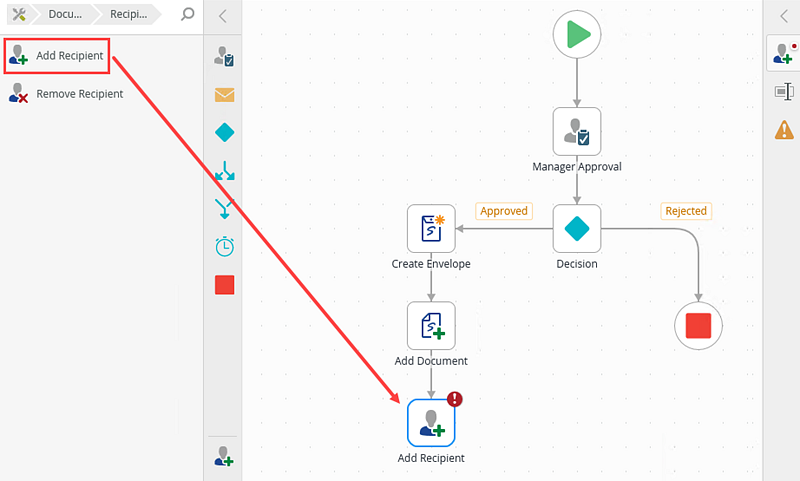 For more information on how to use the error console, see the Error Console topic.
For more information on how to use the error console, see the Error Console topic. - Select the added step and click the expand / collapse toggle to expand the Configuration Panel. You can also double click the step to expand the panel.
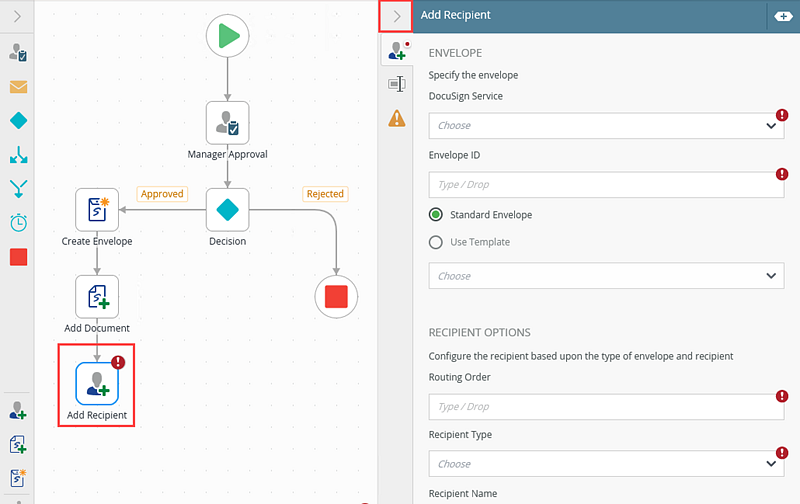
- Select the Add Recipient tab. Use this tab to configure the DocuSign service instance, envelope ID, recipient options, and Return property mappings.
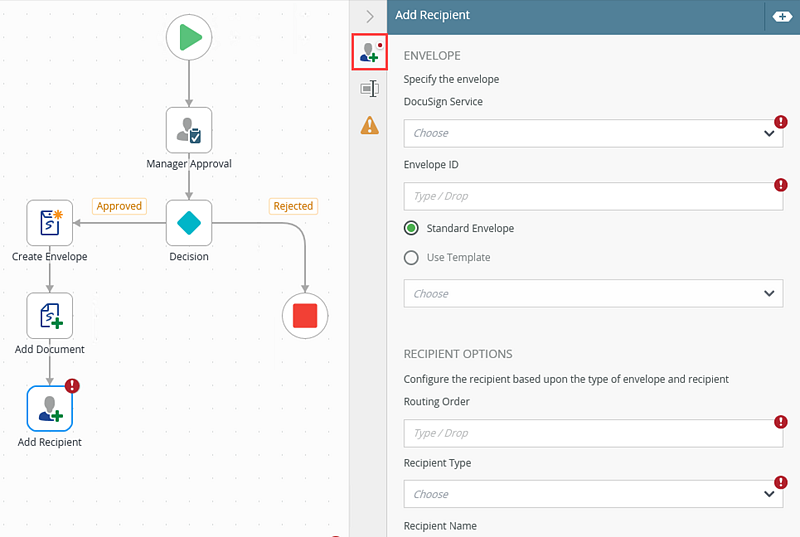
- From the DocuSign Service menu, select the service instance. Add the Envelope ID. Select to use the standard envelope or to use a template.
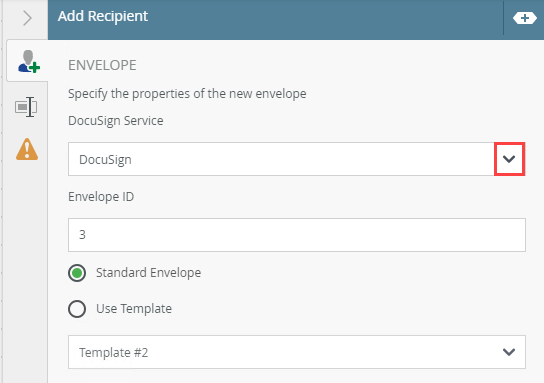
- From the Recipient Options section add the Routing Order. Select the Recipient Type from the menu.
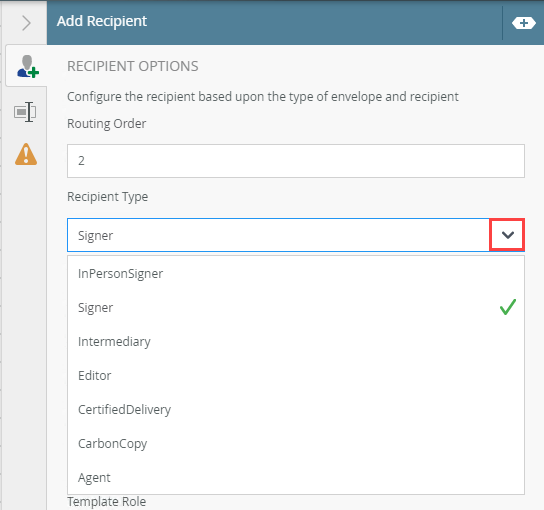
- Add the Recipient Name and Recipient Email Address. Type values or create dynamic values by dragging Functions,
Fields,
SmartObjects and
Workflow-related items from the Context Browser into the fields.

- Check the Use SMS Authentication check box to enable the feature. Add the recipient's mobile number. Type values or create dynamic values by dragging Functions,
Fields,
SmartObjects and
Workflow-related items from the Context Browser into the fields.

- Select the Template Role from the menu. This option is disabled by default. To enable, select the Use Template radio button in the Envelope section.

- Add the Host Name, Host Email Address, Signer Name and Signer Email Address. Type values or create dynamic values by dragging Functions,
Fields,
SmartObjects and
Workflow-related items from the Context Browser into the fields.
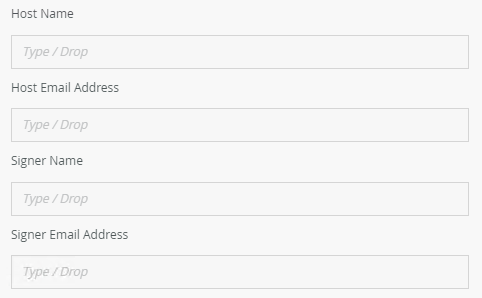
- Click Add to add Optional Attributes. Select the attributes from the list by checking the check box. Type values or create dynamic values by dragging Functions,
Fields,
SmartObjects and
Workflow-related items from the Context Browser into the fields.
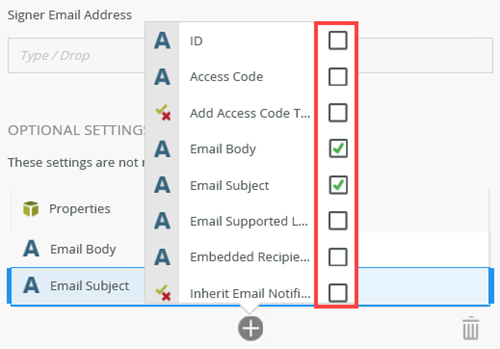 For more information on Optional Settings, please refer to the DocuSign Optional Attributes help content.
For more information on Optional Settings, please refer to the DocuSign Optional Attributes help content. - To delete a setting, select it and click the Trash bin.
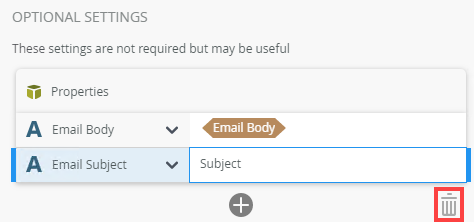
- Configure the Return Properties Mappings. Click Add to add properties. Select a value from the property menu.
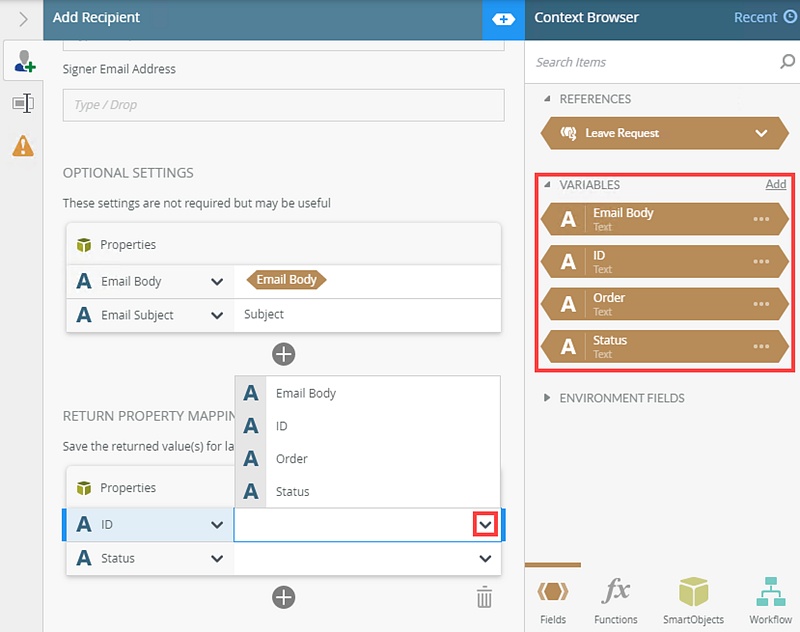
- To add additional properties, click Add.
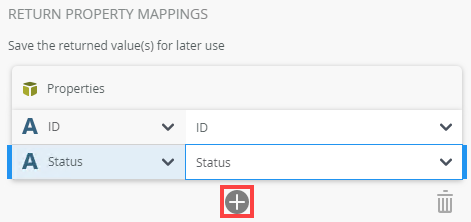
- To delete properties, select them and click the Trash bin.
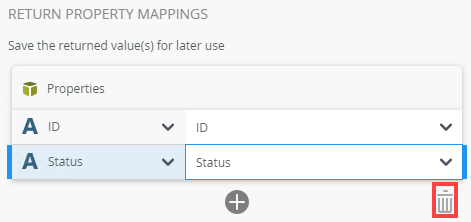
- With the step selected, select the Properties tab.
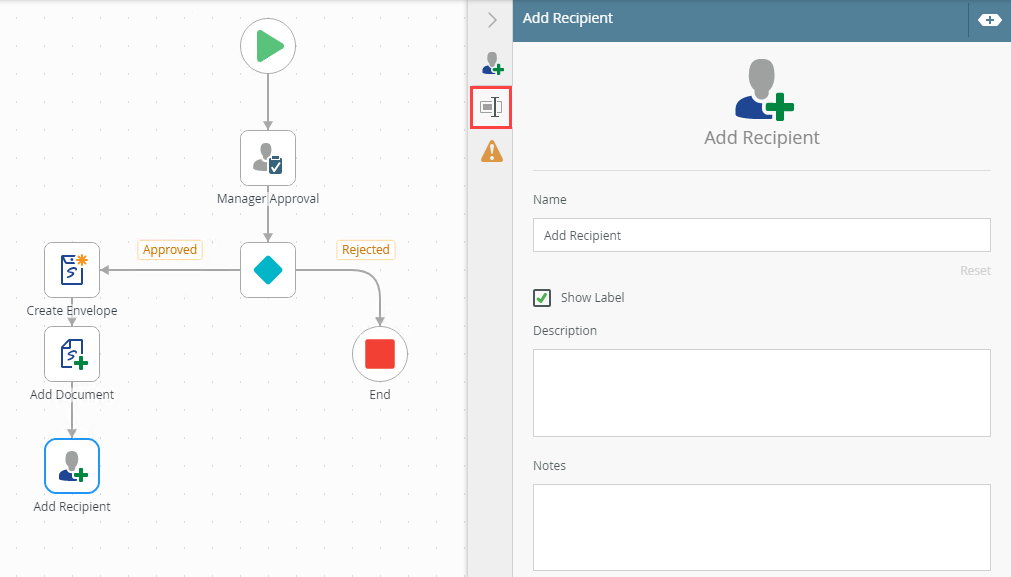
- Click the Errors tab.

- The exceptions in the table above is an example of those available in Workflow steps. The exceptions available depend on the Workflow step used in the design canvas.
When you enable both Continue on Error and Force error when required SmartObject inputs are missing, the workflow continues with execution even if the required inputs are missing. The Continue on Error setting takes precedence.
Your changes are automatically saved.
The following table explains the options available on this tab:
| Option | Explanation | How to Use |
|---|---|---|
DocuSign Service | This is the service instance you registered to integrate with the product. You can register multiple service instances when needed, but only one is required. In the case where you have multiple service instances, and you have templates in another service instance, make sure the templates created in DocuSign are shared if you need them available for all service instances. | Select the service instance from the menu. |
| Envelope ID | The Envelope ID is a common identifier required to perform the functions for this step. It is returned after creating a new envelope. You can store the envelope ID in a variable and use it within this step to retrieve the unique envelope ID corresponding to the workflow instance. | Type values or create dynamic values by dragging Functions, Fields, SmartObjects and Workflow-related items from the Context Browser into the fields. When a SmartObject Load method property is used, an input property is required for the correct data to load. |
| Standard Envelope | Allows you to create a standard DocuSign envelope. | Select the Standard Envelope radio button. |
| Use Template | Allows you to create a new envelope based on a template. This option is useful if you have templates defined for each business purpose, which contains predefined roles. Template roles contain recipient information such as Recipient Type and Order. Adding a recipient using a template role only works when the envelope ID uses the same template. When this option is not used correctly, the following error occurs at runtime: "Service: DocuSign Service Guid: 7b6722f4-3c18-49af-a612-8e6080af4453 Severity: Error. Error Message: The specified recipient could not be found. Recipient ID : '1' InnerException Message:" Select which template to use. | Select the Use Template radio button. Select the template from the menu. |
| Recipient Options | ||
| Routing Order | Allows you to specify the order in which recipients receive the document. | Type values or create dynamic values by dragging Functions, Fields, SmartObjects and Workflow-related items from the Context Browser into the fields. When a SmartObject Load method property is used, an input property is required for the correct data to load. |
| Recipient Type | Allows you to choose the recipient type, for example, Signer. | Select the type from the menu. |
| Recipient Name | Allows you to add the recipient's name. | Type values or create dynamic values by dragging Functions, Fields, SmartObjects and Workflow-related items from the Context Browser into the fields. When a SmartObject Load method property is used, an input property is required for the correct data to load. |
| Recipient Email Address | Allows you to add the recipient's email address. | Type values or create dynamic values by dragging Functions, Fields, SmartObjects and Workflow-related items from the Context Browser into the fields. When a SmartObject Load method property is used, an input property is required for the correct data to load. |
| Use SMS Authentication | Allows you to use SMS authentication by specifying the recipient's mobile number. | Check the check box to enable the feature. Type values or create dynamic values by dragging Functions, Fields, SmartObjects and Workflow-related items from the Context Browser into the fields. When a SmartObject Load method property is used, an input property is required for the correct data to load. |
| Template Role | Select this option if you created your envelope based on a reusable template that contains predefined roles. Template roles contain some of the recipient information such as Recipient Type and Order. This option can only be used with envelopes that are template based. Adding a recipient using a template role only works when the envelope ID uses the same template. Select which role name to use. Note: This option is disabled by default. To enable, select the Use Template radio button in the Envelope section. | Select the role name from the menu. |
| Host Name | Allows you to add the host's name. | Type values or create dynamic values by dragging Functions, Fields, SmartObjects and Workflow-related items from the Context Browser into the fields. When a SmartObject Load method property is used, an input property is required for the correct data to load. |
| Host Email Address | Allows you to add the host's email address. | Type values or create dynamic values by dragging Functions, Fields, SmartObjects and Workflow-related items from the Context Browser into the fields. When a SmartObject Load method property is used, an input property is required for the correct data to load. |
| Signer Name | Allows you to add the signer's name. | Type values or create dynamic values by dragging Functions, Fields, SmartObjects and Workflow-related items from the Context Browser into the fields. When a SmartObject Load method property is used, an input property is required for the correct data to load. |
| Signer Email Address | Allows you to add the signer's email address. | Type values or create dynamic values by dragging Functions, Fields, SmartObjects and Workflow-related items from the Context Browser into the fields. When a SmartObject Load method property is used, an input property is required for the correct data to load. |
| Option Settings | Depending on how you configure this step, DocuSign exposes different additional options that can be set for the recipient. These are not required but are used by DocuSign if they are set. The available options vary based on how the other settings are configured. For more information on Optional Settings, please refer to the DocuSign Optional Attributes help content. | Type values or create dynamic values by dragging Functions,
Fields,
SmartObjects and
Workflow-related items from the Context Browser into the fields. When a SmartObject Load method property is used, an input property is required for the correct data to load. Click Add to add additional property fields. |
| Return Property Mappings | Return properties listed here are mapped to variables. This allows you to make use of these values in other steps in the workflow. Create a field and drag it from the Context Browser to the return property. The value of this property is stored in the variable for each workflow instance. | Select properties and supply return values. Type values or create dynamic values by dragging Functions, Fields, SmartObjects and Workflow-related items from the Context Browser into the fields.When a SmartObject Load method property is used, an input property is required for the correct data to load. Click Add to add additional property fields. |
The following table explains the options available on this tab:
| Option | Explanation | How to Use |
|---|---|---|
| Title / Name | By default, each step on the canvas has a step title. You can change this title to suit your workflow logic and show it on the canvas by checking the Show Label box. | Enter a value into the Title/Name field. |
| Reset link | Use the link to reset any changes to the title. | Click the Reset link to reset the Title/Name field to default value. |
| Show Label | Allows you to see the step label on the canvas. The label shows the value of the title. | Check the check box to display step label on the canvas. |
| Description | Allows you to add a detailed description for the step. | Enter a value into the Create New field. |
| Notes | Allows you to add additional notes for the step. | Enter a value into the Notes field. |
Different types of exceptions can occur on a step, such as:
| Type | Description |
|---|---|
| Known exceptions | Any SmartWizard or standard wizard that has Boolean options for handling known exceptions have these options displayed as check boxes in the Known exceptions section of the Exceptions tab. |
| Unhandled exceptions | Any unknown runtime exceptions. |
The tab contains the following known exceptions:
| Exception | Explanation | How to Use |
|---|---|---|
| Continue on error | On step execution and an error occurs, continue to the next step in the workflow. | Check the check box to continue if an error occurs. Uncheck the check box to stop workflow execution if an error occurs. |
The tab contains the following unhandled exceptions:
| Exception | Explanation |
|---|---|
| Log Exception | Logs the exception to the error log. |
| Force error when required SmartObject inputs are missing | Will forcefully throw an error if a SmartObject method has input missing. |
| Continue on error | Will force the workflow to continue running the SmartObject method, even if it runs into an error. |
When working with the Add Recipient step keep in mind the following consideration:
- The DocuSign Service Instance must be registered before using this wizard. For information on how to do this, see DocuSign feature activation.
- Use the Create Envelope step first, which is typically the starting point when building a workflow containing DocuSign steps